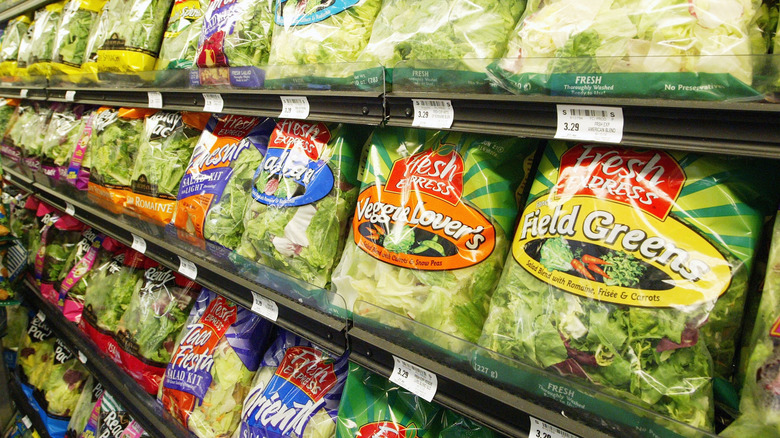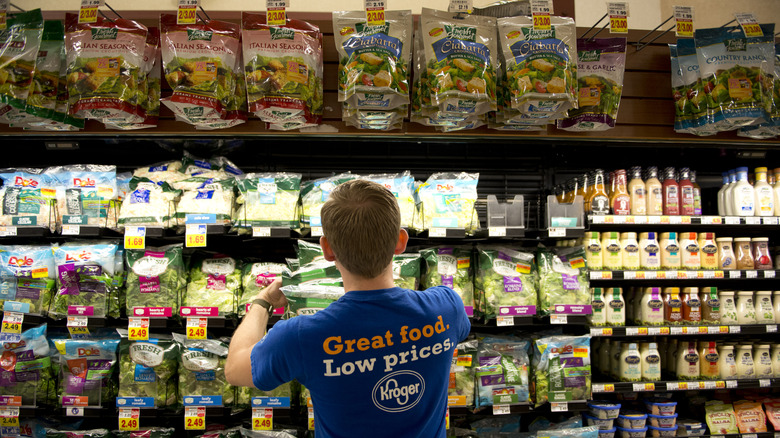Your Bagged Salad Will Last Way Longer If You Remove Those Wilted Leaves
When it comes to wasting food and money, nothing quite tops bagged salad. While these pre-washed, chopped, and expertly mixed bags of salad are time-savers when you're making dinner and packing lunches, they're also one of the things people throw away most often; as much as 40% of bagged salad ends up in the trash. You can blame a lot of salad waste on aspirational shopping, aka buying fresh salad mix in the hopes that it will become a healthy meal. Salad mix has a short shelf life, but you don't have to resign yourself to wasting pricey baby greens. All you have to do is store it properly and pick out any wilting leaves right away.
Unless you plan to use the whole bag in one sitting, take the extra step of opening the bag and sorting it before you put it away. Wilted leaves have a way of spoiling the leaves around them, and before you know it, the whole bag is a slimy mess. Just a minute or two of picking can mean the difference between having enough salad for the week and throwing away $5 worth of perfectly good food.
Keep moisture off of the leaves
The bagged salad section of the grocery store has gotten pretty crowded, and it's never been easier to get an interesting bowl of greens on the table. You'll pay for this convenience, however. A bag of prepped salad greens costs at least twice as much as the same lettuce sold by the head. Because it's already been cut, washed, and packaged, bagged salad has already been around for at least six days. Add in the time it takes to get from the processing facility to the supermarket, and you've got four or five days, tops, before the leaves start to turn slimy.
The first thing to do any time you bring home a bag of salad mix is to open up the package, sort through it to see if there's any leaves that are starting to turn, and then repackage the salad greens in a plastic bag with a zipper top or a plastic container.
Any excess moisture on the leaves will encourage spoiling, so spin the mix quickly in a salad spinner and then pull everything apart to look for rotting leaves. When the leaves are jammed into the bag together, rot can spread quickly from leaf to leaf. When you sort the bad pieces out of the mix, you'll slow the spoiling process for the whole batch of lettuce.
Keep the bag chilled
In addition to keeping salad greens dry and avoiding excess moisture, you'll need cool temperatures to discourage spoiling. (If you've ever left a bowl of salad out on the counter for an hour, you know it doesn't take long for lettuce to wilt.) If bagged lettuce gets too warm, the same thing will happen, and more leaves will get slimy and gross.
Once you have the salad mix picked and prepped, pack the mix in a large Ziploc bag. Toss a paper towel in the bag to absorb any excess moisture, and then store the whole thing in the crisper drawer, which is designed especially for keeping vegetables fresher longer. Don't forget to label and date the container. While there's no danger of not knowing when the salad has gone bad, the day and date will be a visual reminder of when the salad hit the fridge and how long you have to eat it while it's in peak form.
It's never a good feeling to toss a bag of expensive salad mix in the trash, and salad is one of the biggest contributors to food waste. If you take just a few minutes to pick through the lettuce leaves when it first comes into the house and then store it properly, you can squeeze a few extra days out of your greens.


